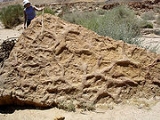
Thalassinoides
Encyclopedia
Thalassinoides is an ichnogenus of trace fossil
, also known as Ophiomorpha, Teichichnus, Gyrolithes and Spongeliomorpha. Thalassinoides is used to refer to "dichotomously or T-branched boxworks, mazes and shafts, unlined and unornmented", and facies of Thalassinoides increased suddenly in abundance at the beginning of the Mesozoic
. Such burrows are made by a number of organisms, including the sea anemone
Cerianthus, Balanoglossus
and fish
es, but are most closely associated with decapod
crustacean
s of the infraorder Thalassinidea
.
Trace fossil
Trace fossils, also called ichnofossils , are geological records of biological activity. Trace fossils may be impressions made on the substrate by an organism: for example, burrows, borings , urolites , footprints and feeding marks, and root cavities...
, also known as Ophiomorpha, Teichichnus, Gyrolithes and Spongeliomorpha. Thalassinoides is used to refer to "dichotomously or T-branched boxworks, mazes and shafts, unlined and unornmented", and facies of Thalassinoides increased suddenly in abundance at the beginning of the Mesozoic
Mesozoic
The Mesozoic era is an interval of geological time from about 250 million years ago to about 65 million years ago. It is often referred to as the age of reptiles because reptiles, namely dinosaurs, were the dominant terrestrial and marine vertebrates of the time...
. Such burrows are made by a number of organisms, including the sea anemone
Sea anemone
Sea anemones are a group of water-dwelling, predatory animals of the order Actiniaria; they are named after the anemone, a terrestrial flower. Sea anemones are classified in the phylum Cnidaria, class Anthozoa, subclass Zoantharia. Anthozoa often have large polyps that allow for digestion of larger...
Cerianthus, Balanoglossus
Balanoglossus
Balanoglossus is an ocean-dwelling acorn worm genus of great zoological interest because, being a Hemichordate, it is an "evolutionary link" between invertebrates and vertebrates...
and fish
Fish
Fish are a paraphyletic group of organisms that consist of all gill-bearing aquatic vertebrate animals that lack limbs with digits. Included in this definition are the living hagfish, lampreys, and cartilaginous and bony fish, as well as various extinct related groups...
es, but are most closely associated with decapod
Decapoda
The decapods or Decapoda are an order of crustaceans within the class Malacostraca, including many familiar groups, such as crayfish, crabs, lobsters, prawns and shrimp. Most decapods are scavengers. It is estimated that the order contains nearly 15,000 species in around 2,700 genera, with...
crustacean
Crustacean
Crustaceans form a very large group of arthropods, usually treated as a subphylum, which includes such familiar animals as crabs, lobsters, crayfish, shrimp, krill and barnacles. The 50,000 described species range in size from Stygotantulus stocki at , to the Japanese spider crab with a leg span...
s of the infraorder Thalassinidea
Thalassinidea
Thalassinidea is an infraorder of decapod crustaceans that live in burrows in muddy bottoms of the world's oceans. In Australian English, the littoral thalassinidean Trypaea australiensis is referred to as the yabby , frequently used as bait for estuarine fishing; elsewhere, however, they are...
.

